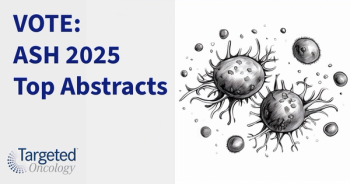
Neoadjuvant T-VEC Demonstrates Consistent Efficacy Improvements in Resectable Melanoma at 5 Years
The oncolytic virus T-VEC showed consistent improvements at 5 years for patients with stage IIIB to IVM1a melanoma.
The use of oncolytic virus T-VEC (talimogene laherparepvec; Imlygic) as a neoadjuvant treatment demonstrated consistent efficacy improvements at 5 years vs surgery alone for patients with stage IIIB to IVM1a melanoma, according to long-term results from a phase 2 study (NCT02211131) presented at
At the final 5-year analysis of the open-label study, the 5-year relapse-free survival (RFS) rate was 22.3% with T-VEC prior to surgery, compared with 15.2% for surgery alone (HR, 0.76; 80% CI, 0.60-0.97). At 5 years, 77.3% of patients treated with T-VEC prior to surgery were alive compared with 62.7% with surgery alone (HR, 0.54; 80% CI, 0.36-0.81). The event-free survival (EFS) rate at 5 years was 43.7% with T-VEC vs 62.7% with surgery alone (HR, 0.57; 80% CI, 0.43-0.76).
“The primary end point was relapse-free survival, and this was not the conventional relapse-free survival. It does not only count all the local, regional, and distant recurrences, [but] it also counts all the patients who withdrew to go to surgery and all the R1 and R2 resections,” lead investigator Reinhard Dummer, MD, University Hospital Zurich, Switzerland, said during a presentation of the results. “If the surgeon failed to completely resect the melanoma lesion, this is already counted as a relapse event.”
T-VEC is administered as a local injection directly to the tumor site. The therapy consists of herpes simplex 1 virus that has been genetically modified to secrete the cytokine GM-CSF, which causes cell lysis. Additionally, the lysis results in the release of tumor-derived antigens resulting in activation of an immune response. “There is both activation of T cells and natural killer cells with T-VEC,” Dummer said.
In the study, patients were randomized to surgery (n = 75) or 6 doses of intralesional T-VEC followed by surgery. Surgery was completed over a span of 6 weeks. T-VEC was administered as ≤4 ml x 106 plaque-forming units (PCU)/ml at week 1. After 3 weeks, it was administered at ≤4 ml x 108 PCU/ml over 2 weeks. Surgical resection in the T-VEC arm was completed from week 13 to week 18.
The baseline characteristics were balanced between arms for T-VEC plus surgery and surgery alone. In the T-VEC arm, the median age was 63.5 years and nearly two-thirds were male (64.5%). The most common ECOG score was 0 (88.2%) and the disease stages were well balanced, with the most common stage being IIIC. Most patients had received a prior surgery for melanoma (93.4%) and a minority had received radiotherapy (5.3%).
There were more patients enrolled in this study with in-transit melanoma than other neoadjuvant studies, Dummer said. There were 21.1% of patients in the combination arm with in-transit disease and 23% in the surgery arm. Additionally, there were patients with nodal involvement and in-transit disease (22.4% vs 23%, respectively).
“One patient that I treated had extensive in-transit disease with multiple lesions, and there was a pronounced response in all of them and by histology this patient shows a complete remission,” said Dummer.
Following surgery, adjuvant therapy was determined by investigator's choice. In the T-VEC arm, 13.7% of patients received adjuvant therapy (n = 10), which most often consisted of immunotherapy (n = 8). More patients received adjuvant therapy in the surgery alone group (31.9%; n = 22), with immunotherapy being the top choice half of the time (n = 11). Approximately half of patients in the T-VEC arm received a subsequent therapy in any setting (54.8%) compared with over three-fourths in the surgery group (78.3%).
“In this final readout of the largest randomized neoadjuvant trial for an oncolytic virus in advanced melanoma, we report durable improvements in RFS, EFS, and overall survival at 5 years with neoadjuvant T-VEC plus surgery vs standard surgery,” said Dummer. “These results suggest that an intratumorally-administered oncolytic agent can elicit a meaningful long-term systemic effect and support neoadjuvant T-VEC plus surgery in advanced resectable melanoma.”
Caroline Robert, MD, PhD, head of the Dermatology Unit at Gustave Roussy, discussed the findings during the session at the ESMO meeting. She noted the results of the study favored T-VEC and that the low toxicity profile associated with the oncolytic virus gave it an advantage against more active but also more toxic regimens, like nivolumab (Opdivo) plus ipilimumab (Yervoy). However, she questioned the statistical plan used for the trial.
“There was potential bias in the randomization, a gap between the 2 arms in treatment timing, and an absence of visibility of the timing of events, especially in the combination arm,” she said. “The relaxed alpha error of 80% confidence interval means there's a 20% risk to conclude that the result is positive, whereas it is not, with the upper end of the confidence interval close to 1. Results may not have been significant if a more standard 95% CI had been chosen.”
Additional studies continue to assess T-VEC in the neoadjuvant setting for patients with melanoma, either as a single agent or in combination with other therapies. A study in the Netherlands is looking at T-VEC with nivolumab (NCT04330430) and another conducted at the University of California, Davis, is assessing it as a single agent (NCT04427306). Both studies are in phase 2 and currently recruiting participants.
Reference
Dummer R, Gyorki D, Hyngstrom J, et al. Final 5-year results of the phase II, multicenter, randomized, open-label trial of talimogene laherparepvec (T-VEC) neoadjuvant treatment (Tx) plus surgery vs immediate surgery in patients (pts) with resectable stage IIIB-IVM1a melanoma (MEL). Ann Oncol. 2022;33(suppl 7).DOI:10.1016/j.annonc.2022.08.037









































